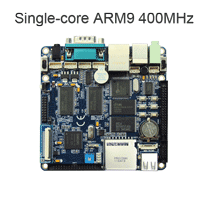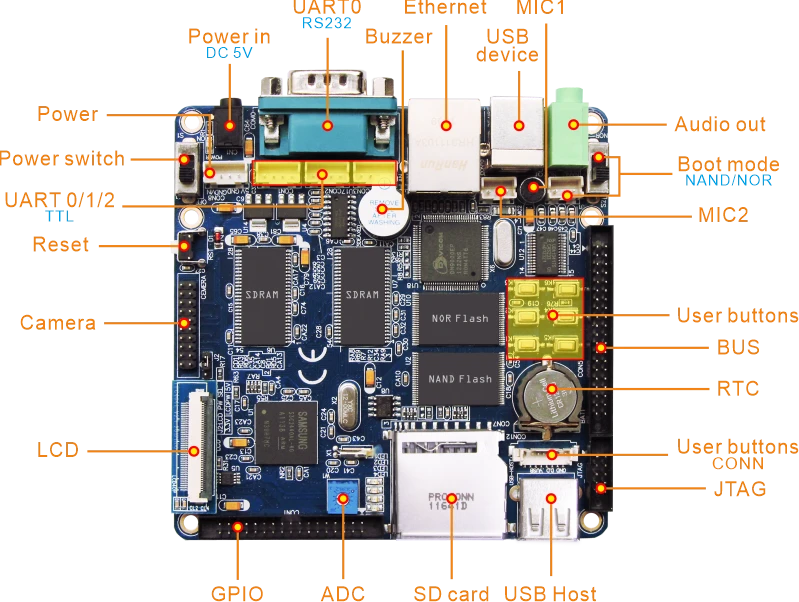COM0. In the default WinCE image (BSP) the COM0 is being used as debug port, however you can configure it as normal serial port.
Products
- -Single board computer
- +Rockchip
- SBC3588 Idea3588 Idea3588S SBC3576 EM3576 SBC3568 EM3568 EM3568-AV CAM SBC3566 EM3566 EM3562 EM3326S Idea1126 EM1126 SBC3399 Idea3399 EM3399 Idea3288 EM3288 EM1808 EM3128 EM1103B SBC1108

* Processor: Samsung ARM9 S3C2440A ARM920T, 400MHz
* RAM: 64MB/128MB
* Storage: 128MB/256MB/512MB/1GB
* Interface: USB Host, USB Device, RS232, 3x TTL UART, LCD, Ethernet, Camera, JTAG, Audio, GPIO, SD, User button connector
* Operating system: Linux 2.6.32, WinCE6.0(R3)
* Dimensions: 100 x 100 mm
* Expansion Module: 4.3-inch LCD, 7-inch LCD
The EM2440 is a small single-board computer with plenty of I/O and several options for touch-screen LCD interfaces. This SBC is based on a Samsung ARM9 S3C2440 microprocessor and capable of supporting both Windows CE6.0(R3) and Linux 2.6.32 OS, and measures 10cm x 10cm, 6-layer PCB turmeric craftwork. The principal attraction of the EM2440 is all the I/O. In particular, there are a number of 3- and 4-pin shells with serial, audio and power connections, and a 34-pin shrouded IDC header which carries processor GPIO, clocks and I2C signals. It is ideal for learning about ARM systems or integrating into numerous products.



| Specifications | |
|---|---|
| SoC | Samsung S3C2440A ARM920T core @ 400 MHz. |
| SDRAM | 64MB/128MB SDRAM |
| Storage | 256MB/512MB/1GB NAND Flash SD/MMC card slot |
| NOR Flash | 2MB with BIOS |
| Serial Ports | The three serial ports are led out on CON1 (UART0), CON2 (UART1) and CON3 (UART2). UART0 is also connected to a RS232 level converter and led out on COM0 (DB9 connector) |
| LCD | 4.3-/ 7- inch TFT LCD with resistor touch screen |
| Ethernet | 10/100 Mbps Ethernet RJ45 port via DM9000EP controller |
| USB | USB Host1.1 ( type A) USB Device1.1 (type B) For communication control the USB Device has got an additional pin: USB_EN (GPC5). |
| Camera | 2mm pitch 20 pins connector. |
| JTAG | 2mm pitch 20 pins JTAG Port |
| Audio codec | Adopt UDA1341 Audio chip. 1x 3.5mm jack for audio out 1x MIC for audio input1 1x 3-pin connector for audio input2 |
| ADC | There are four ADC channels on the board which are connected to the GPIO header (CON4). AIN0 is also connected to a 10k potentiometer (W1). |
| GPIO | 34-pin 2.0mm pitch connector |
| Buzzer | On-board PWM function test unit. The Buzzer is connected to GPB0 |
| Buttons | 6x User Buttons. The user buttons are led out on CON12. |
| Reset | The reset circuit uses a MAX811 reset IC and there is an additional reset switch on the board: RST |
| Dimensions | 100 x 100 mm |


| OS | Item | Feature | Description |
|---|---|---|---|
| Linux2.6.32 | Bootloader | Boot | Start up system, supporting one Key to update Bootloader, Kernel, Yaffs, NK.bin and one Key to configure parameters of Linux. Also can be configured the board booting from Yaffs or NFS |
| Tftp | Support tftp transmitting protocol | ||
| File system | Yaffs2 | ||
| Kernel | Support writing kernel image into nand flash and kernel parameter setting | ||
| Etc. | Support via USB and Serial Interface to download application to flash debug | ||
| Kernel | Version | Linux kernel 2.6.32.2 | |
| File system | CRAMFS /EXT2/FAT32/NFS /YAFFS2 | ||
| Serial device | Three serial ports | ||
| Ethernet | 10/100 Mbps Ethernet, DM9000 | ||
| RTC | RTC driver | ||
| USB Host | USB Host, USB Slave driver | ||
| LEDs | Four LEDs driver | ||
| Buttons | User buttons | ||
| Language | Multi-language Support | ||
| LCD | Coming with driver for 4.3" and 7" TFT LCD | ||
| Touch panel | Touch panel driver | ||
| SD/MMC card | SD/MMC card driver | ||
| Sound | UDA1341 | ||
|
USB Camera |
The chip of USB Camera is Vimicro 301p, the USB Camera is collecting dynamic picture and showing on the LCD |
||
| Embedded GUI | Qt/Embedded | Qt/Embedded 2.2+QtE-4.6.3 | |
| Application | Test applications | CMOS Camera, ADC Testing, Button Testing, PWM Testing, LCD Testing, Watchdog Testing, EEPROM Testing, LED Test, Serial Port test, Ping Testing, Recorder, Network setting, Backlight Testing, Language setting, Pen Pad | |
| Servfox | The application is running under Console platform, it controls the USB Camera by internet and displays the picture taken by camera on the LCD. It can be taken as net monitor when the application works with USB Camera. | ||
| Spcacat | It is a camera picture capture application under Console platform | ||
| Snapshot | It is a LCD picture capture application under Console platform | ||
| Rz and sz | It is a application that transfer and receive file by serial port | ||
| Madplay | It is a MP3 player | ||
| Network protocol | TCP/IP | TCP/IP protocol | |
| Telnet | Telnet server, telnet remote login | ||
| File transfer | FTP Client/server | ||
| Web server | boa web server | ||
| USB port supported Devices | U-disk, portable hard-disk, USB mouse, USB Keyboard, USB Camera and so on. | ||
| Command commands | cat, chmod, discard, echo, flashfsd, flashwrite, free, genhtml, hostname, init, kill, loader, ls, mkdir, mount, ps, reboot, rm, smanaged, sysconf, yes, insmod, lsmod, rmmod | ||
| Tools | busybox1.13 | ||
| OS | Item | Feature | Description |
|---|---|---|---|
| WinCE6.0(R3) | Bootloader | stepldr | Copy Eboot to SDRAM to jump to Eboot |
| Eboot | Ethernet bootloader for wince, support downloading image through USB device port. supporting one Key to update Bootloader, Kernel, Yaffs, NK.bin and one Key to configure parameters of Linux | ||
| Driver (source Code) | Serial device | Three serial ports | |
| Ethernet | 10/100 Mbps Ethernet, DM9000 | ||
| USB Host | USB Host driver, supporting USB ActiveSync | ||
| USB Device | USB Device driver | ||
| RTC | Real time keeping | ||
| LED | LED1 | ||
| Buttons | User buttons | ||
| LCD | Coming with driver for 4.3" and 7" TFT LCD | ||
| CMOS Camera | OV9650 CMOS Camera | ||
| ADC | ADC driver | ||
| Touch Screen | Touch Screen driver | ||
| Audio | UDA1341 | ||
| SD/MMC card | Block devices drivers | ||
| Applications Example | AutoRun Setting, CMOS Camera, ADC Testing, Button Testing, PWM Testing, LCD Testing, Watchdog Testing, EEPROM Testing, LED Test, Serial Port test | ||
 EM2440 PCB Dimension (564KB)
EM2440 PCB Dimension (564KB)
 Samsung S3C2440A datasheet (2.1MB)
Samsung S3C2440A datasheet (2.1MB)
If you order the Development Kit or any question, please feel free to contact us at market@armdesigner.com
To change the runtime OS feature you will need the WinCE Platform Builder 5.0 (for WinCE5.0)/Visual Studio 2005 for WinCE6.0, as well as the BSP (board support package) that we provided in the shipped DVD. For application development you can use the EVC (Embedded Visual C++).
There are evaluation versions of the above mentioned tools available on the Microsoft download site, full version of those tools can be bought from a local Microsoft distributor.
Be sure to copy it to the folder "Resident Flash".
There are three ways to achieve this:
1, Add the application (MyApp.exe for example) and its shortcut to the NK, and add the shortcut to the StartUp folder;
2, add the application to the NK and add something like below the registry:
[HKEY_LOCAL_MACHINE\init]
"Launch80"="MyApp.exe"
"Depend80"=hex:1E,00
3, by modifying the registry we can even replace the shell (explorer.exe), for example:
[HKEY_LOCAL_MACHINE\init]
"Launch50"="explorer.exe"
"Depend50"=hex:14,00, 1e,00
replace the "Launch50"="explorer.exe" with "Launch50"="MyApp.exe" so that we can disable the explorer and set our own application as the default sheel.
MTD partition is defined in the file "arch/arm/plat-s3c/include/plat/partition.h", you may modify the partition information by modifying this file.
Normally such "bad blocks" are not real bad blocks. These blocks can be marked as bad blocks due to some faulty operations. Generally we can have this solved by running the "nand scrub" command in the uboot prompt, note that "nand scrub" will erase everything in your NAND, so please be sure to backup your data before doing this. Anyway, a few "real" bad blocks in the NAND Flash is normal and allowed and they would not effect anything.
There are two possibilities:
1. The kernel image (zImage) has not been well installed.
In this case you just need to follow the user manual to install the zImage.
2. Incorrect u-boot parameter.
Is it possible to move my application software into the on-board NAND flash instead of CF/SD?
With this case please calibrate the touchscreen again according following steps.
1. #rm /etc/pointercal
2. Reset the board
3. The system will show you a window with cross-point to calibrate the touchscreen
You need to prepare a logo image (png format), such as the name of linux_logo.png, please run under the linux: The settings are shown as the following directory.
# pngtopnm linux_logi.png > linux_logo.pnm
# pnmquant 224 linux_logo.pnm > linux_logo224.pnm
# pnmtoplainpnm linux_logo224.pnm > logo_linux_clut224.ppm
Finally will be generated a file of logo_linux_clut224.ppm, then replace the file in the directory "\drivers\video\logo\logo_linux_clut224.ppm", and begin to recompile.
For WinCE, users only need to choose according to their own LCD screen display resolution modify the macro definition of different screen in the file "bsp_cfg.h" under the directory "\SRC\INC".
For Linux QT, execute the command "make menuconfig" , then setting according to the following directory "Device Drivers –> Graphics support –> Support for frame buffer devices" , select the corresponding LCD screen LCD Type. Detailed methodology please refer to the corresponding user manual.
For Android, if you are switching between resistive screen, you can modify the parameters of LCD in the bootargs under the uboot environment variable. If you are switching between the resistive and capacitive touch panel screen, you need to execute "make menuconfig" in the kernel, then setting according to the following directory "Device Drivers –> Input device support –> Touchscreens" , select the appropriate option to configure.


